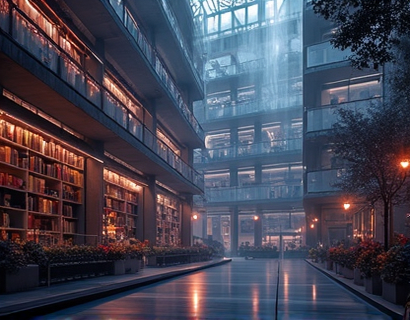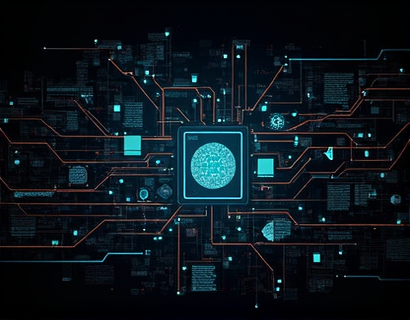Unlocking the Future of Digital Engagement: AI and Crypto Synergy for Enhanced User Experiences
The intersection of artificial intelligence and cryptocurrency is redefining the digital landscape, offering unprecedented opportunities for enhanced user experiences. This synergy is not just a technological marvel but a transformative force that is reshaping how we interact online. As we delve into this topic, it's essential to understand the foundational roles that AI and cryptocurrency play individually, and how their integration is creating a new paradigm in digital engagement.
Artificial intelligence, with its ability to process vast amounts of data, learn from patterns, and make decisions with minimal human intervention, has become a cornerstone of modern technology. From personalized recommendations on streaming platforms to advanced fraud detection in financial transactions, AI's impact is pervasive. Its capacity to analyze and interpret complex data sets in real-time makes it an invaluable tool for enhancing user experiences.
Cryptocurrency, on the other hand, represents a revolutionary approach to digital currency and transactions. Built on blockchain technology, it offers transparency, security, and decentralization. The immutable nature of blockchain ensures that transactions are tamper-proof, while the decentralized network reduces the risk of single points of failure. These features make cryptocurrency an attractive solution for secure and efficient digital interactions.
The convergence of AI and cryptocurrency is particularly exciting because it leverages the strengths of both technologies. AI can enhance the functionality and security of cryptocurrency systems, while cryptocurrency can provide a robust and transparent framework for AI applications. This synergy is paving the way for more interactive, secure, and user-centric digital environments.
Enhancing Connectivity through AI and Crypto
One of the most significant benefits of integrating AI and cryptocurrency is the enhancement of connectivity. Traditional online platforms often struggle with scalability and performance issues, especially during peak usage times. AI-driven solutions can optimize network traffic, reduce latency, and improve overall system efficiency. When combined with the decentralized nature of cryptocurrency, these improvements become even more potent.
For instance, AI can be used to predict and manage network congestion by analyzing usage patterns and dynamically adjusting resources. This proactive approach ensures a smoother user experience, even as the number of users grows. Cryptocurrency, with its decentralized architecture, supports this by providing a resilient and scalable infrastructure that can handle increased loads without central bottlenecks.
Moreover, the use of smart contracts in cryptocurrency can automate and streamline various processes, from content delivery to user authentication. AI can enhance these smart contracts by adding layers of intelligence, such as adaptive access controls and predictive maintenance, further bolstering the robustness of the system.
Creating Interactive and Innovative Online Environments
The integration of AI and cryptocurrency is not just about improving backend processes; it's also about creating more engaging and interactive frontend experiences. AI-powered chatbots and virtual assistants can provide instant, personalized support to users, enhancing their interaction with digital platforms. These AI entities can understand natural language, learn from user preferences, and adapt their responses over time, making the user experience more intuitive and seamless.
In the context of cryptocurrency, AI can be used to develop sophisticated trading bots that analyze market trends, identify opportunities, and execute trades with high precision. These bots can be integrated into user-friendly interfaces, allowing even novice users to participate in the crypto market with confidence. The transparency of blockchain ensures that all transactions are visible and verifiable, adding an extra layer of trust and security.
Furthermore, AI can enhance the creative aspects of digital environments. For example, AI-generated content, such as images, music, and even code, can be used to create unique and dynamic user experiences. In the realm of cryptocurrency, AI can power decentralized applications (dApps) that offer novel functionalities, from virtual real estate to gamified financial games, all backed by secure and transparent blockchain technology.
Security and Trust in AI-Crypto Ecosystems
Security is a paramount concern in both AI and cryptocurrency domains, and their integration offers a comprehensive solution to these challenges. AI can significantly improve the security of cryptocurrency systems by detecting and mitigating threats in real-time. Machine learning algorithms can identify unusual patterns and anomalies, flagging potential security breaches before they occur. This proactive approach to security is crucial in a landscape where cyber threats are constantly evolving.
Blockchain's inherent security features, such as cryptographic hashing and consensus mechanisms, provide a solid foundation for secure transactions. When combined with AI's advanced analytical capabilities, the result is a highly secure and trustworthy ecosystem. Users can have confidence in the integrity of their data and transactions, knowing that AI and blockchain are working together to protect their interests.
Additionally, AI can enhance the user authentication process in cryptocurrency platforms. Biometric verification, behavioral analysis, and other AI-driven methods can provide multi-layered security, reducing the risk of unauthorized access. This not only safeguards user assets but also builds trust in the platform, encouraging more widespread adoption.
Personalization and User-Centric Design
One of the most transformative aspects of AI in digital environments is its ability to deliver personalized experiences. By analyzing user behavior, preferences, and interactions, AI can tailor content and functionalities to individual needs. This level of personalization is particularly valuable in the crypto space, where users often seek control and autonomy over their digital assets.
AI can curate personalized portfolios, provide customized market insights, and offer tailored investment strategies. For example, an AI-powered dashboard can present users with real-time data, predictive analytics, and actionable recommendations, all presented in an intuitive and user-friendly manner. This not only enhances the user experience but also empowers users to make informed decisions.
Moreover, AI can help in designing user interfaces that are more intuitive and accessible. By understanding user interactions and feedback, AI can suggest improvements to the user interface, ensuring that the platform is easy to navigate and use. This user-centric approach is essential for retaining users and fostering a loyal community.
Decentralized AI and the Future of Crypto
The concept of decentralized AI is gaining traction as a natural extension of the blockchain paradigm. Decentralized AI involves distributing AI computations and data across a network of nodes, eliminating the need for centralized servers. This approach not only enhances privacy and security but also promotes fairness and transparency.
In the context of cryptocurrency, decentralized AI can be used to develop decentralized machine learning (DMLL) models. These models can be trained on data from multiple sources without compromising user privacy, as the data remains on the users' devices. The aggregated results can then be used to improve AI algorithms, creating a continuous loop of enhancement and innovation.
Decentralized AI also opens up new possibilities for decentralized finance (DeFi) applications. By integrating AI into DeFi platforms, users can benefit from smarter, more efficient, and more secure financial services. For instance, AI-driven lending and borrowing platforms can assess creditworthiness more accurately, reduce default risks, and offer competitive interest rates.
Challenges and Considerations
While the potential of AI and cryptocurrency integration is vast, there are several challenges and considerations that need to be addressed. One of the primary concerns is the regulatory landscape. As both AI and cryptocurrency operate in relatively uncharted territories, regulatory frameworks are still evolving. Ensuring compliance while fostering innovation is a delicate balance that requires collaboration between technologists, policymakers, and industry stakeholders.
Another challenge is the technical complexity involved in integrating AI and cryptocurrency systems. Developing robust, scalable, and secure solutions requires expertise in multiple domains. There is a need for interdisciplinary collaboration to overcome these technical hurdles and create seamless, user-friendly applications.
Privacy is also a critical issue. While blockchain's transparency is a strength, it can also expose sensitive information. AI can help mitigate this by implementing advanced encryption techniques and zero-knowledge proofs, ensuring that user data remains confidential while still being verifiable.
Conclusion
The synergy between AI and cryptocurrency is revolutionizing digital engagement, offering enhanced user experiences through increased connectivity, interactivity, and security. As these technologies continue to evolve, the possibilities for innovation are endless. For tech enthusiasts, digital innovators, and early adopters, embracing this synergy is key to staying ahead in the rapidly changing digital landscape. By leveraging the power of AI and cryptocurrency, we can unlock new frontiers in digital interaction, creating more intuitive, secure, and empowering online environments.










































